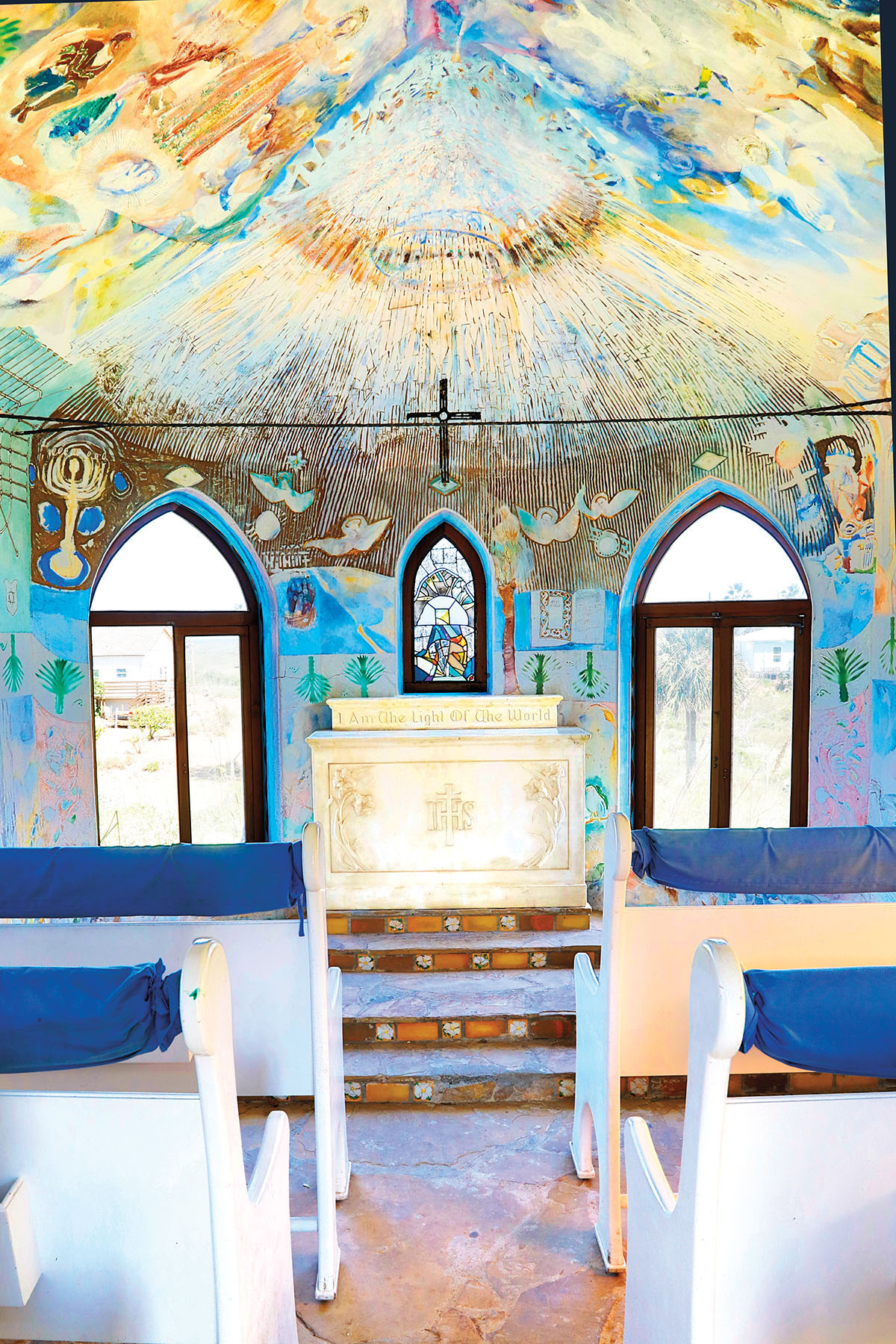
High atop a sand dune in Port Aransas, a small white sanctuary overlooks the ocean. Seagulls glide in the salty air above swaying sea oats and flowering cacti. The Chapel on the Dunes is the oldest continuously functioning church on Mustang Island, and over the past eight decades, as visitors and hurricanes came through, it has become a symbol of strength and longevity in this coastal community. “It’s like our own little Sistine Chapel,” says Cliff Strain, executive director of the Port Aransas Preservation and Historical Association. The group lists the chapel as one of its “Eight Wonders of Port Aransas,” a collection of tourist spots including such institutions as Farley Boat Works and the Tarpon Inn.
Chapel on the Dunes
203 S. 11th St., Port Aransas.
chapelonthedunes.org
The chapel, shaped like an irregular convex hexagon, was conceived by San Antonio native Aline B. Carter, a Renaissance woman whose wide-ranging interests included natural sciences, the arts, poetry, and music. Educational opportunities were very limited for women in the early 1900s, but Aline’s father, Frank Badger, wanted her to have the best instruction possible. She studied at three schools in Boston, Massachusetts: the Eric Pape School of Art, Boston Conservatory, and Wellesley College, where she developed her love of astronomy. She later taught the subject to young students at San Antonio’s Witte Museum and even added an observatory at the Maverick Carter House, her historic home-turned-museum in the city’s downtown.
In those days, the journey south to Mustang Island from San Antonio could take up to eight hours by car, followed by a 25-minute ferry ride, which meant Aline and her family would stay for a month or more at a time. Aline had a chapel in her home in San Antonio, and she desired a similar sanctuary to complement her summer house, a 1937 structure made by combining two fishing cabins. The island, only 18 miles long, has had churches dedicated to Baptists, Catholics, and Presbyterians, but Aline wanted one that was open to all. “She was Episcopalian but had Universalist views,” says Carter Brown, Aline’s great-grandson.
Aline’s “Chapel of Eternal Light”—as she called it in her letters—was completed in 1938, with the help of San Antonio artisan Ethel Wilson Harris. Aline conceived of the chapel’s design and details, down to the carved flowers on the altar and the tile work, while Harris oversaw the construction. Many of the religious institutions on the island had been destroyed during the 1919 hurricane that ravaged the Gulf Coast. So Aline’s chapel established itself as not only a place of weekly worship for the island, but also a destination for meditation, inspiration, and appreciation of the natural world. Following Sunday school, she’d serve ice cream and cake to the kids, who called her the “White Angel” for the flowing white dresses she frequently wore.
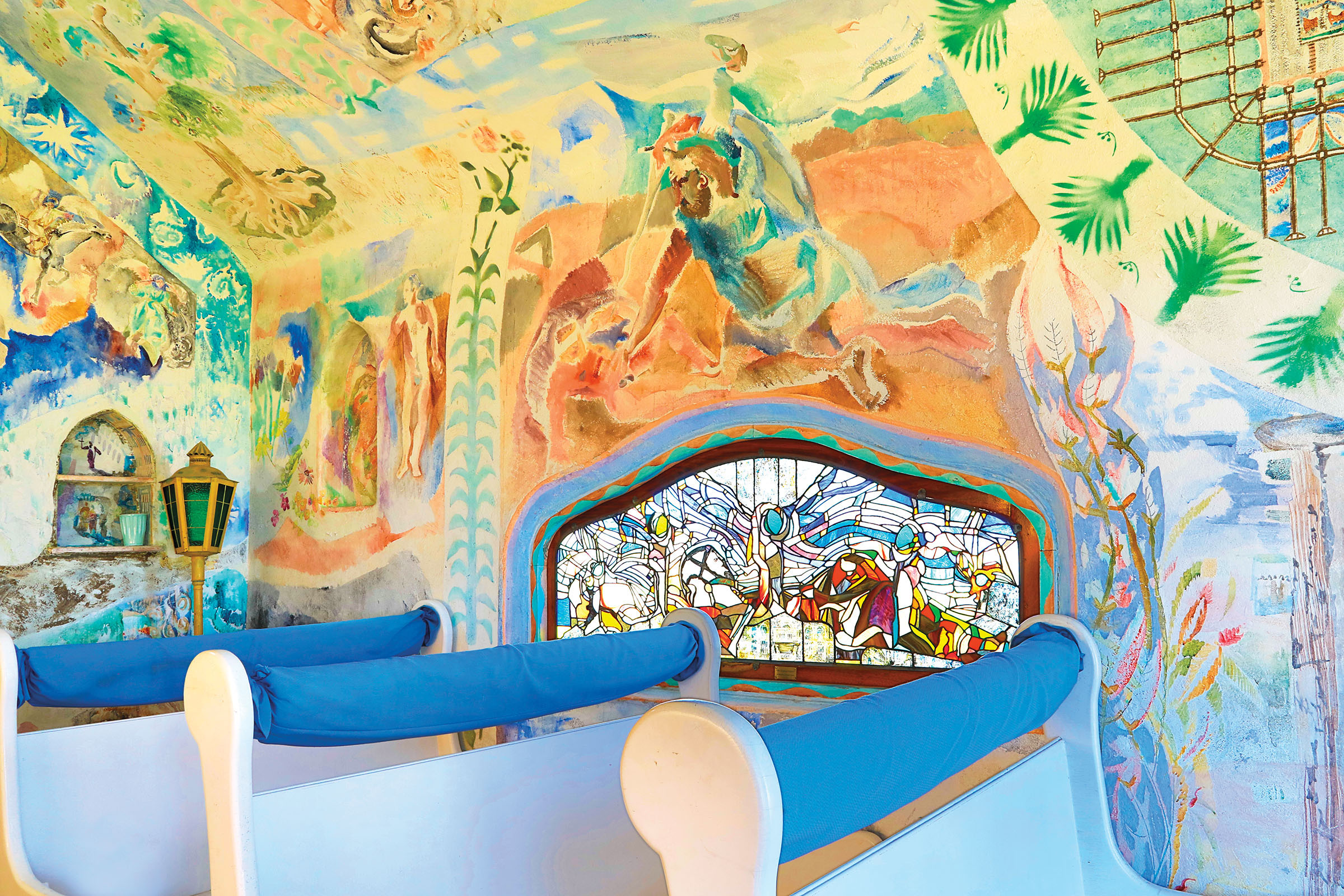
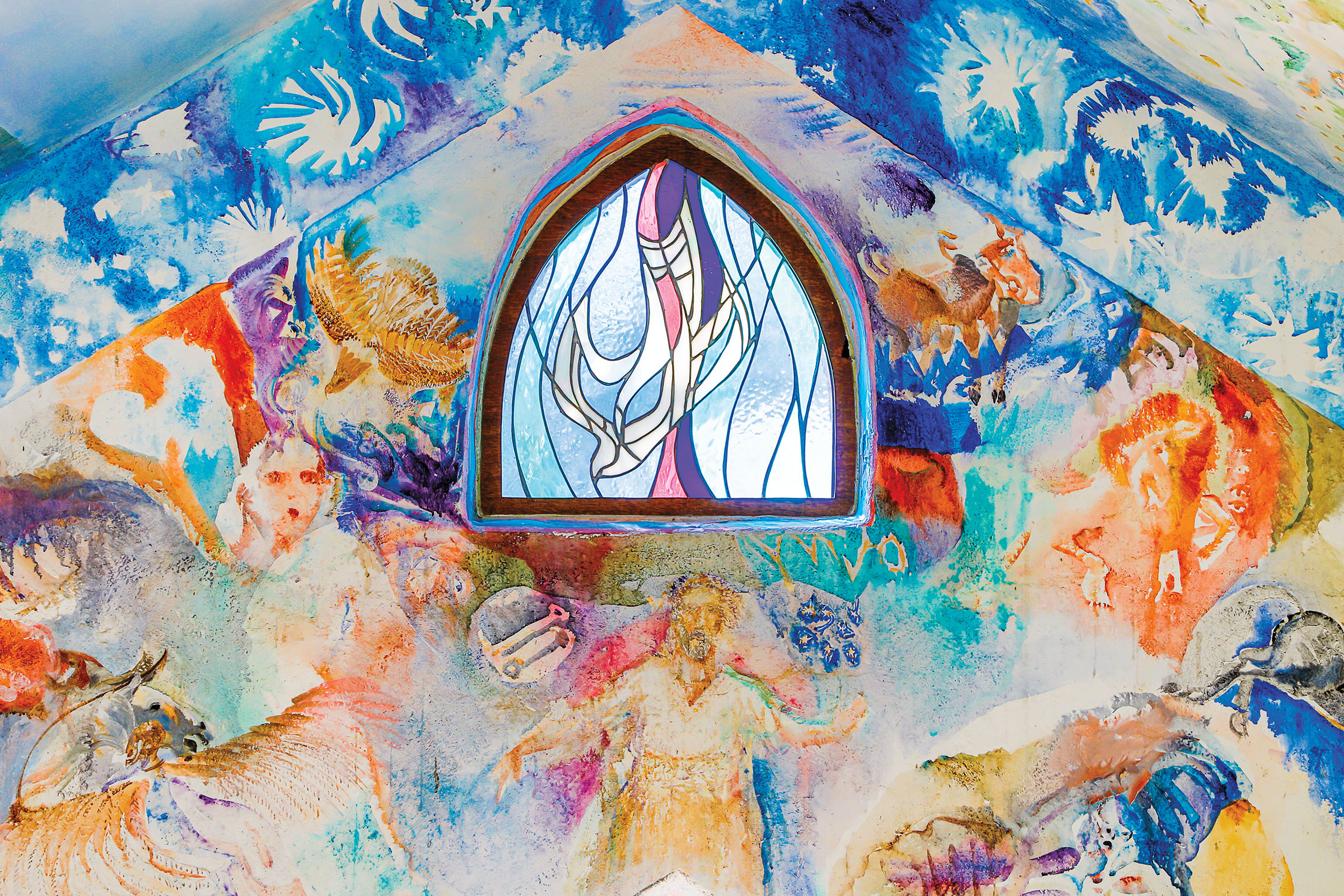
In 2018, the Carter family congregated at the chapel to celebrate the life of Frank Carter, Aline’s son, who was lovingly called the “Chapel Keeper.” Frank lived on the island and looked after the sanctuary beginning in the early 1970s. He took pleasure in sharing it with visitors up until his death at age 99. Though he’s passed on, the family and the Port Aransas Historical Museum continue to look after the sanctuary. They’ve recently repainted the exterior, repaired the walkway, and partnered with one of the original vendors, Voss Metal Works, to restore the windows and the door to their original 1930s design. Glass plating is also being added to the stained-glass windows to keep them protected from future storms.
“It has been through some of the worst direct-hit hurricanes, and it just comes out shining,” says Marline Carter Lawson, Aline’s granddaughter. The chapel even weathered Hurricane Harvey, with the exception of a few lost roof shingles and one broken window.
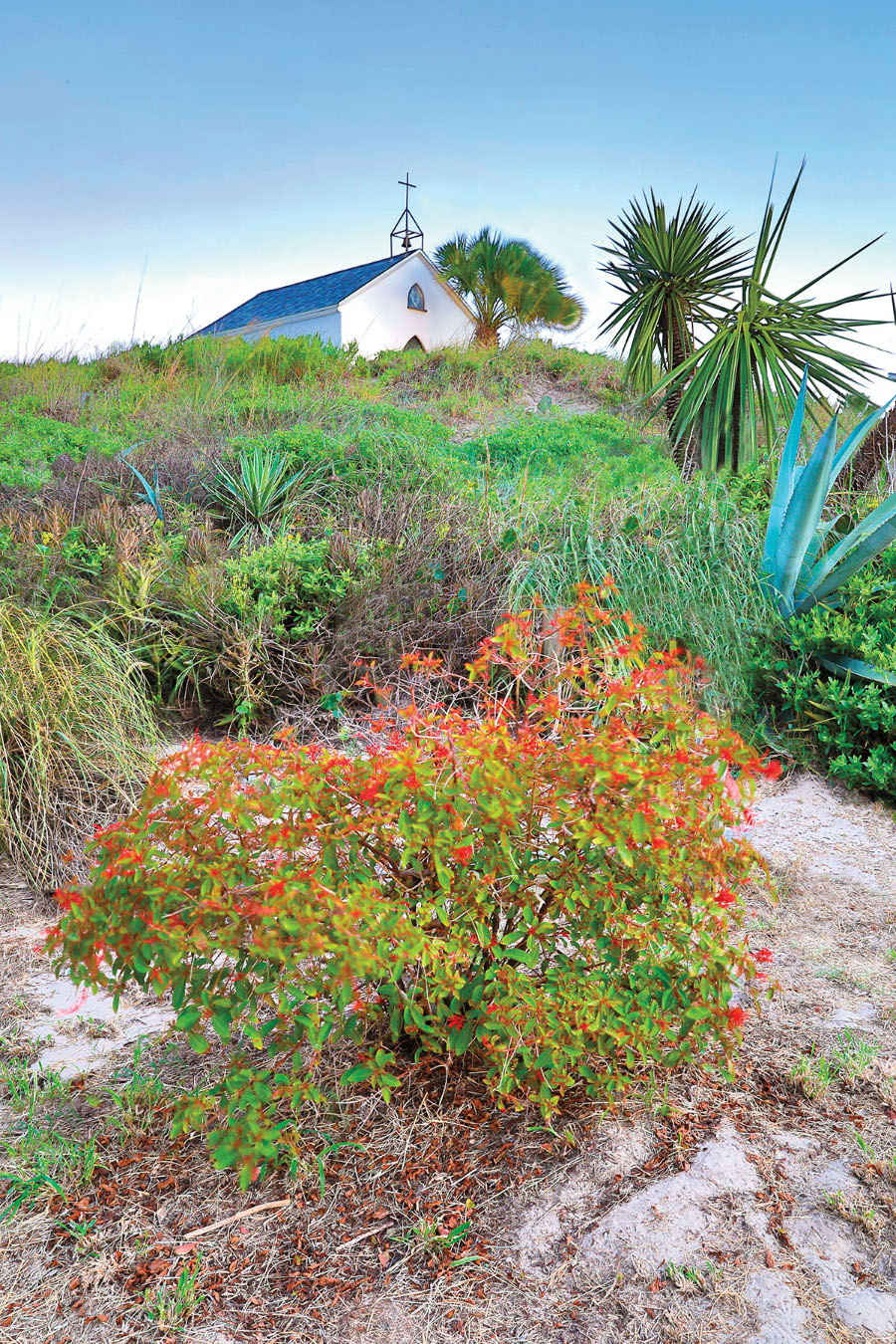
The Chapel overlooks Port Aransas’ Old Town neighborhood.
At 26 feet above sea level, the Chapel on the Dunes hovers high above Port Aransas’ Old Town neighborhood, as if lifted in prayer. “When those sea breezes blow through the windows, it creates a very heavenly sight up on that sand dune,” Lawson says. It’s a picturesque vision, but like most things in life, it’s the chapel’s inner beauty that lingers in memory.
After Aline died in 1972, Austin-based artist John Patrick Cobb was commissioned to paint the history of Christianity on the chapel’s interior walls. He removed the white paint from the stucco and painted stories from the Old and New Testaments on the north and south walls. Every stroke is a wash of kaleidoscopic color: pale peach, periwinkle, sage green, shell pink.
“Approaching Frank Carter about the hopeful restoration of the chapel was, essentially, done for my own redemption,” Cobb says. “I was given a true freedom both from Frank and even from the creator to express the joy of life.”
Viewing the murals for the first time is a spellbinding experience, an unexpected discovery dripping with stars, symbolism, revelations, and seascapes. Inside, there are six white benches for parishioners and a carved marble altar bearing the biblical scripture I Am the Light of the World. The stained-glass windows on either side of the aisle actively absorb sunlight, casting rays of orange and gold onto the flagstone floors.
Over the years, people have visited the chapel to see Cobb’s murals, to experience a piece of Port Aransas history, and to find peace in their own lives. Event rentals and free tours are available through the Port Aransas Historical Museum. “If there is any kind of spark that someone picks up, we are happy,” Brown says.
Today, 82 years after its consecration, the chapel remains privately owned by the Carter family and is poetically positioned on one of the island’s highest sand dunes—fitting, considering its originator served as the Texas Poet Laureate from 1947 to 1949. In 1948, Aline also co-founded Texas Poetry Day with Lucia Trent. Aline’s legacy and love of the written word lives on in Port Aransas with the Aline B. Carter Chapel on the Dunes Poetry Prize for Young Poets, which is open to all students at Port Aransas High School and Brundrett Middle School. Awards are presented on Texas Poetry Day, celebrated annually on Oct. 15.
At 250 square feet, the Chapel on the Dunes may be small, but its importance to this community looms large. “To me it represents the unity of Port Aransas,” Lawson says. “I think the island embraces it as its own.”
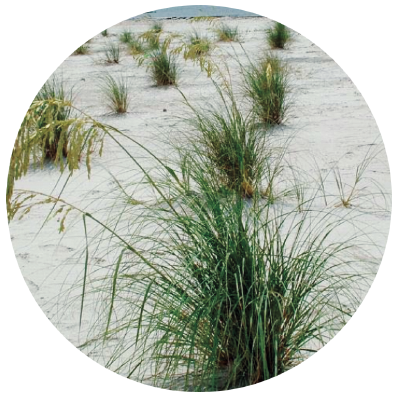
Grassroots
For Cliff Strain, executive director of the Port Aransas Preservation and Historical Association, the tall, swaying sea oats surrounding the Chapel on the Dunes look like “proud feathery flags.” This wild coastal grass is important to the stability of the dunes on Mustang Island. Their latticed root structure holds sediment and stimulates plant growth. Colonies are generally isolated as the weight of their seeds inhibits them from traveling far with the wind. “The fact that sea oats are not found everywhere makes them a unique attraction,” Strain says. “To the eye and mind of a naturalist, they bring a feeling of beauty and strength in our local environment.”








